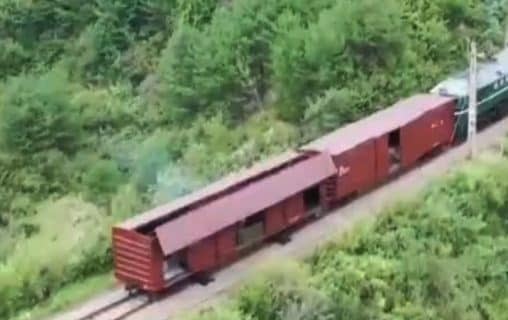How Ukraine is being used as a test bed for Kim Jong-un’s pet project
- Oops!Something went wrong.Please try again later.

When Russian forces first launched a North Korean missile at Ukraine, it landed in a field outside the southern city of Zaporizhzhia.
The United States said the attack had probably ended in abject failure.
Since then, Western analysts and the US have estimated that as many as 50 North Korean-produced short-range ballistic missiles have been used by Russia against Ukraine.
Those looking for clues on who gains what from Vladimir Putin’s trip to the hermit nation of North Korea could do worse than studying the battlefields of Ukraine.
While Putin is an obvious beneficiary of more weapons, Kim Jong-un is also gathering indispensable knowledge and intelligence on his own fledgling missile programme.
“North Korea has been able to test the efficacy of their small arms in various other conflicts around the world, but they haven’t been able to test their missiles anywhere,” Samuel Ramani, a fellow at the RUSI think tank, said.
Since North Korea started sending weapons to Russia, it has shipped at least 10,000 containers, Shin Won-sik, South Korea’s defence minister, said last week.
They have been stuffed full of 152-millimetre artillery shells, 122mm rockets, anti-tank missiles and portable surface-to-air missiles.
Putin has said the two countries’ relationship will be ramped up to a “new level” in a new partnership signed on Wednesday during his state visit to North Korea.
Their trade in missiles has been less well publicised.
But declassified US intelligence has directly linked fragments of rockets found in Ukraine to images of Kim touring a missile factory.
Open source investigations by arms control experts have revealed those missiles to be two variations of the Hwasong-11 – the A and B models.
The solid-fuel ballistic missiles are said to be able to carry both conventional and nuclear warheads of up to 500kg for almost 300 miles at speeds of Mach 4.0.
They can be launched from transporter erector launchers (TEL) mounted on either trucks or trains.
The munitions are often compared to the Russian Iskander ballistic missiles, both visually and technically.
US intelligence revealed that the first Russian cargo planes started collecting “missiles and missile-related cargo” from North Korea in November last year before taking them to a firing range in western Russia for testing.
It is probable that Moscow has a small number of TELs, which can carry two missiles, and the necessary support vehicles, according to a report by the International Institute for Strategic Studies think tank.
The North Korean missiles launched by Russian forces have been “very low” quality with an accuracy rate of around 20 per cent, Yuriy Belousov, one of Ukraine’s top war crimes investigators, said in March.
Those launches resulted in the deaths of 24 people and injured over 100 more, he added.
The North Korean missiles are cobbled together using hundreds of commercial, non-military grade electronic components sourced from companies in the US and Europe.
Evidence suggests that the weapons used by Russia were produced as late as 2023, most likely in a rush so they could be shipped quickly for immediate use.
Given that the Hwasong is based on the Russian Iskander, Moscow would be able to swap munitions for knowledge.
This is also relevant in the wider field after a North Korean rocket carrying a spy satellite exploded mid-flight.
“The failure of North Korea’s recent attempted spy satellite launch shows that the country still needs technical assistance in this field – which Russia is well placed to offer,” Justin Crump, an analyst.
Sanction-ravaged Pyongyang has also struggled to feed its people in recent decades.
It has been forced to approach its allies to fix the food shortages because it has never been able to produce enough for its 26 million population.
“Russia needed ammunition because it drained out a lot of what they could get out of the ammunition dumps in Belarus. Iran was willing to supply drones but was hesitating on the supply of missiles,” Dr Ramani said.
“That’s what the Russians wanted from North Korea and the North Koreans were happy to oblige because they’ve wanted to find an alternative, reliable partner to China economically and to supply them with food, with energy. And Russia is much more willing than China to overtly undermine the UN sanctions regime.”
Mr Crump added: “Such basic staples as food and other commodities offer Russia bargaining power in its quest for arms.”


